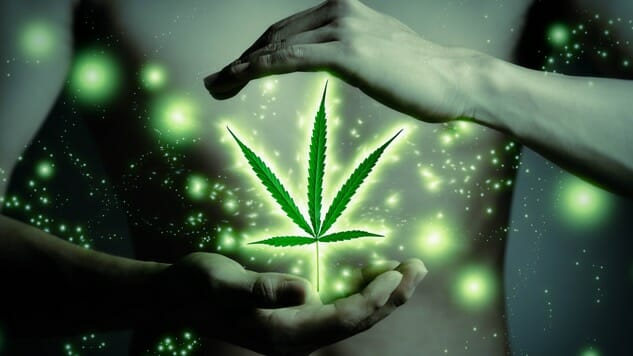Cannabis Connection: The Gateway Drug Theory You’ve Never Heard
Image: Shutterstock/tomkawila
Two days ahead of the famed 420 stoner holiday, Homeland Security Secretary John Kelly let it be known that the Trump Administration will soon bring the hammer down on cannabis. “Let me be clear about marijuana,” said the former Marine at George Washington University in D.C. “It is a potentially dangerous gateway drug that frequently leads to the use of harder drugs.”
He later added, ”[Cannabis] use and possession is against federal law, and until the law is changed by the U.S. Congress, we in DHS are sworn to uphold all the laws on the books.”
Sec. Kelly’s public comments place him in the prohibitionist camp alongside Attorney General Jeff Sessions, Press Secretary Sean Spicer and our pro-tobacco Vice President Mike Pence. However, his gateway reference is surprising since few people still espouse the theory or cite it as justification for locking up American citizens for state-legal use in their private residences. Even the anti-cannabis Food & Drug Administration (FDA)—which egregiously recommended cannabis remain a wholly prohibited Schedule I substance in 2016—admitted deep in its report (page 35 of 39) that ”[40 years of] research does not support a direct causal relationship between regular marijuana use and other illicit drug use.” Likewise, an Americans for Safe Access’ (ASA) legal motion filed against the Drug Enforcement Administration (DEA) forced the agency to remove the gateway drug theory from its website as it violated the Information Quality Act (i.e., a law that prohibits the government from posting bullshit).
That’s right, the Homeland Security Department is ready to re-escalate the costly and ineffective war on cannabis based in part on a discredited theory that even the DEA and FDA no longer publicly support. Still, a major irony exists in this latest drug war ripple. While the original gateway theory might be going the way of the dodo bird, an alternate gateway theory is gaining credibility that the Trump brain trust should consider. But first, let’s take a closer look at the original gateway claim.
Super narc Harry Anslinger, who launched a dishonest and racist anti-cannabis crusade in the 1930s, successfully instituted prohibition with claims that the worse-than-opium plant turned (mostly ethnic) smokers into raving mad rapists and murderers (mostly targeting virginal white women). The American Medical Association (AMA) vigorously called out Anslinger’s propaganda, but the politicians went with the bureaucrat over the medical community. Still, the public eventually started to question the reefer madness claims, so Anslinger pivoted to the stepping-stone theory. This gateway precursor claimed cannabis was a stepping-stone to heroin and harder drugs.
In 1951, the U.S. Addiction Research Center noted a spike in heroin addiction, and Congress wanted to fight heroin abuse by imposing mandatory prison minimums for violations. Anslinger immediately campaigned to include cannabis because it’s the stepping-stone. He testified, “Over 50 percent of those young addicts started on marijuana smoking. They started there and graduated to heroin; they took the needle when the thrill of marijuana was gone.”
The director of the U.S. Addiction Research Center vigorously called out Anslinger’s propaganda, stating, “Marijuana smokers generally are mildly intoxicated, giggle, laugh, bother no one, and have a good time…. It has not been proved that smoking marijuana leads to crimes of violence or to crimes of a sexual nature.” The politicians again sided with the bureaucrat over the nation’s top addiction researcher, and the Boggs Act of 1952 created mandatory minimums for cannabis-use crimes.
In 1975, the stepping-stone became a gateway. A clinical study in the Science journal claimed cannabis, alcohol and tobacco were behavioral gateways that led to heroin, cocaine and other heavy drug use. Researchers never identified a biological mechanism that prompted escalation to harder drugs, so the findings were largely based on correlations and observations. By the time President Reagan reignited the Drug War, most people accepted the gateway drug theory as fact, and it became a mainstay in prohibitionist propaganda. As recently as 2015, the National Institute on Drug Abuse (NIDA) seemed to back the theory with claims that cannabis primes the brain for enhanced responses to other drugs, though a 2017 update now treats it as one of several possibilities.
“An alternative to the gateway-drug hypothesis is that people who are more vulnerable to drug-taking are simply more likely to start with readily available substances such as marijuana, tobacco, or alcohol, and their subsequent social interactions with others who use drugs increases their chances of trying other drugs,” noted the updated NIDA text.
NIDA had to make the change because countless studies debunked the theory in the past decade. The Drug and Alcohol Dependence journal published findings in 2012 that suggest common underpinnings best explain the progression to stronger drugs, while a 2010 study in the same journal demonstrated how the theory completely falls apart in countries with less prominent cannabis cultures. For example, nearly 83 percent of people who use hard drugs in Japan did not try cannabis first. In its 2016 report, the FDA also noted that many people progress from heroin to cannabis in countries where cannabis is less common.
If the evidence strongly suggests that cannabis is not a gateway drug, what is this alternate theory? Well, the new theory suggests that prohibition, not cannabis, is what swings the gate wide open.
-

-

-

-

-

-

-

-

-

-

-

-

-

-

-

-

-

-

-

-

-

-

-

-

-

-

-

-

-

-

-

-

-

-

-

-

-

-

-

-








































